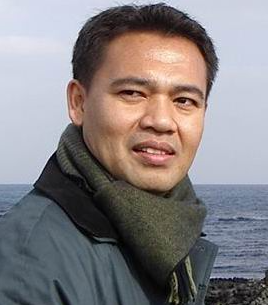| SUBMISSION |
| About JMH |
| Editorial Team |
| Reviewer Acknowledgment |
| Publication Ethics |
| Focus and Scope |
| Author Guidelines |
| Peer-review Process |
| Contact |
| Journal History |
Journal of Medicine and Health (JMH) is an open access journal (OAJ), a periodic scientific publication biannually online published in February and August, using review and screening system by peer group reviewer. Scientific articles dealing with the following topics in medicine, health, new developing therapy from traditional medicine or herbs and developing clinical therapy are particularly welcome.
This journal encompasses original research articles, case report, and review articles (only selected writer), including continuing medicine and health study, dentistry topics, molecular biology medicine, stem cell study and functional food.
All papers submitted to this journal must be written in good Bahasa Indonesia or English. For the English language article, authors for whom English is not their native language are encouraged to have their paper be checked before submission for grammar and clarity. The work should not have been published or submitted for publication elsewhere.
All manuscripts must be submitted to JMH using Online Submission Service at the following URL address: https://journal.maranatha.edu/index.php/jmh,
where Author should register first as Author Role. If authors have any problems with the online submission, please contact Editorial Office at the following email: [email protected]
A Covering Letter outlines the basic findings of the paper, and its significance should accompany the manuscripts submitted by online through online submission interface (upload as Supplementary Files):
Three types of manuscripts are acceptable for our publication: Original Research Articles, Case reports, and Review Articles (only selected authors).
The manuscript should be prepared according to the following author guidelines in the MS Word (doc, docx, pdf) article template format: MS Word Template (.docx)
Every submitted paper is independently reviewed by at least two peer-reviewers through a double-blind process. The decision for publication, amendment, or rejection is based upon their reports/recommendations and made solely by Editor. If two or more reviewers consider a manuscript unsuitable for publication in this journal, a statement explaining the basis for the decision will be sent to the authors after the submission date.
Manuscripts sent back to the authors after revision should be returned to the editor without delay. The revised manuscript should be uploaded to the Online Submission Interface.
The revised document is file of "Revised Manuscript file" according to Template-based format (MS Word file) (please yellow-color highlighted texts in the revised sentences).
Author should first register as Author Role and may be offered as Reviewer through the following address: https://journal.maranatha.edu/index.php/jmh/about/submissions
The Author should fulfill the form as detail as possible where the star marked form must be entered. After all form textbox was filled, Author clicks on “Register” button to proceed with the registration. Therefore, Author is brought to online author submission interface where Author should click on “New Submission”. In the Start a New Submission section, click on “’Click Here’: to go to step one of the four-step submission process”. The following are four steps in the online submission process:
After this submission, the Authors who submit the manuscript will get a confirmation email about the submission automatically. Therefore, Authors can track their submission status at any time by logging in to the online submission interface. The submission tracking includes a status of manuscript review and editorial process.
Journal of Medicine and Health is a fully open access journal. Readers can read and download any full-text articles for free of charge (fully Open Access) to enhance the readability and citability of articles.
This circumstances can occur if the initial version of the article contains an error, or may have been accidentally sent twice to both JMH and/or a different publisher. In addition, it can also occur due to an element of Infringements of the scientific code of ethics, such as double submissions, false claims of authorship, plagiarism, self-plagiarism, fraudulent use of data or the like. Articles that meet the element of Infringements of the code of ethics upon the awareness of the author can make a withdrawal of his article accompanied by a letter of statement withdrawal addressed to the editorial board of JMH.
The paper will be published in JMH journal after the peer-reviewed process and decided as “Accepted” by Editors. The final paper layout will be reproduced by Editorial Office of JMH journal.
Manuscript content should, in general, be organized in the following order: Title; Authors Name; Authors Affiliation; Abstract; Keywords; Introduction; Materials and Methods; Results and Discussion; Conclusions; Acknowledgments; and References. Manuscript document submitted to this journal (in one MS Word) should be arranged as Body text of the manuscript article (from Title to References, without tables and figures)
Please include Covering Letter in a separate document file containing your summary of scientific findings and uploaded in Supplementary Files.
Bullet and numbering within body text are not allowed. All sentences should be typed as a descriptive paragraph.
Tables are sequentially numbered with the table title and number above the table. Tables should be centered in the column OR on the page. Tables should be followed by a line space (12pt). Elements of a table should be single-spaced. However, double spacing can be used to show groupings of data or to separate parts within the table. Table headings should be in 10pt not bold. Tables are referred to in the text by the table number, e.g., Table 1. Do not show the vertical line in the table. There is only a horizontal line that should be shown in the table, as well as table heading.
Please kindly make sure that tables and figures are referenced and mentioned in the text. When referring to figures or tables, do not use location words, the following examples of references should be avoided: “Based on Figure 1 above….”, “… presented in Table 3 below:
…”, “……. See Table 1 below:”. The table title/caption is placed above the table, while title/caption Image is placed under the image.
Figures are sequentially numbered commencing at 1 with the figure title and number below the figure as shown in Figure 1. Detailed recommendations for figures are as follows:
Equations should be numbered serially within parentheses. The equation should be prepared using MS Equation Editor (not in image format). The equation number is to be placed on the extreme right side. Symbols in the equation should be typed as a paragraph descriptive, not as a bulleted list. The explanation of symbols in the Equation must be described as a paragraph not listed format.
Metric units are preferred and should be consistent throughout body text. Define abbreviations and symbols for the first time as they are introduced in the text. Decimals are written in (.) for English language article and (,) for Indonesian language article.
The manuscript should be typed using word processors (Microsoft Word or Open Office) software. Important: Use of pronouns, such as: I, we, etc., is to be avoided.
Articles submitted to this journal must follow the order below, Title; Writer's name; Author Affiliation; Abstract; Keywords.
For research articles: Introduction/Background; Research objectives, materials, and methods; Results and Discussion; Conclusion.
For case reports: Introduction/ Background; Purpose of writing; Results and Discussion; Conclusion.
For review article: Introduction/Background, Purpose of writing, Method; Results and Discussion; Conclusion.
The whole article can be ended with an acknowledgment, and Reference.
Maximum word count is 20 words no including if there is a subtitle; The title of the article reflects the content; Effective title (please do not use common repetitive words used as "influence.... on...", "relationship between... and” the effect of…).
This is your opportunity to attract the reader’s attention. Remember that readers are the potential authors who will cite your article. Identify the main issue of the paper within the title. Begin with the subject or highlight the idea of the paper. The title should be accurate, unambiguous, specific, and complete. Do not contain infrequently used abbreviations.
Write Author(s) names without a title and professional positions, such as: Prof, Dr, Production Manager, etc. Do not abbreviate your last/family name. Always give your First and Last names (should be at least 2 (two) words). The Middle Name is optional. Write a clear affiliation of all Authors. Affiliation includes the name of department/unit, (faculty), the name of university, address, country. Please indicate Corresponding Author (include email address) by adding an asterisk (*) in superscript behind the name.
Present/permanent address. If an author has moved since the work described in the article was done, or was visiting at the time, a 'Present address' (or 'Permanent address') may be indicated as a footnote to that author's name. The address at which the author did the work must be retained as the main, affiliation address. Superscript Arabic numerals are used for such footnotes.
As per JMH Group policy, no author list changes are permitted after acceptance of an article. The JMH Group production team is instructed to enforce this policy during the production/proofing process.
Authors should carefully consider the list and order of authors before submitting their manuscript. The definitive list of authors should be provided at the time of the initial submission. Any addition, deletion, or rearrangement of author names in the authorship list should be made only BEFORE the acceptance of the manuscript and only if approved by the journal Editor. To request such a change, the Editor must receive the following from the authors: (a) the reason for the change in author list and (b) written confirmation (e-mail, letter) from all authors that they agree with the addition, removal, or rearrangement. In the case of addition or removal of authors, this includes confirmation from the author being added or removed. The Editor retains the right to determine whether the addition or deletion of authors should be performed or not. The addition of deletion of author names in proofs is strictly prohibited.
Please be noted that only one author is allowed to be a Corresponding Author of an article which is indicated by an asterisk (*) symbol. The Corresponding Author may different from the Submitting Author. The Submitting Author may submit the manuscript on behalf of the Corresponding Author. However, other Authors may include their email addresses in addition to an email of corresponding authors.
The Corresponding Author is the one individual who takes primary responsibility for communication with the journal during the manuscript submission, peer review, and publication process. Corresponding Author are senior researchers or group leaders with some – or a lot of experience – in the submission and publishing process of scientific research. They are someone who has not only contributed to the paper significantly but also can ensure that it goes through the publication process smoothly and successfully.
An abstract should stand alone, which means that no citation and figures and equation format in the abstract. Consider it the advertisement for your article. The abstract should tell the prospective reader what you did and highlight the key findings. Avoid using technical jargon and uncommon abbreviations. You must be accurate, brief, clear and specific. Use words that reflect the precise meaning. The abstract should be precise and honest. Please follow the word limitations (200 words).
Keywords are the labels of your manuscript and critical to correct indexing and searching, minimum consists of 5 words/phrases, each word/phrase in keyword should be separated by a semicolon punctuation (;), not a comma (,). Therefore, the keywords should represent the content and highlight of your article. Use only those abbreviations that are firmly established in the field. e.g., DNA.
In the Introduction, Authors should state the objectives of the work at the end of the introduction section. Before the objective, Authors should provide an adequate background (maximum 1 paragraph) and very short literatures survey/review in order to record the existing solutions/method, to show which is the best of previous research, to show the main limitation of the previous researches, to show what do you hope to achieve (to solve the limitation), and to show the scientific merit or novelties of the paper or GAP ANALYSIS.
Three main requirements that there is must available in introduction: State of the art, gap analysis and the aim of the conducted study. Avoid a detailed literature survey or a summary of the results. Do not describe pieces of literature survey/review as author by author but should be presented as group per method or topic reviewed which refers to some literatures. Before the objectives and after the literatures review, author must state the gap analysis or novelties statements to show why does this paper is important and what is unique idea of this paper compared to other previous researchers' suggestions.
One of the examples of novelty statement or the gap analysis statement in the end of Introduction section (after state of the art of previous research survey):
“........ (Short summary of background) ....... ....(put here state of the art or overview of previous researches similar to this research).............. A few researchers focused on There
is no researcher concerned on ........ Therefore, this research focuses on.................. Therefore,
this research is aimed to ”.
Or
“........ (Short summary of background)............ (put here state of the art or overview of previous
research like this research) .............. A few researchers focused on...................... There have
been limited studies concerned on ........ Therefore, this research intends to.................... The
objectives of this research are......... ”.
Materials and methods should make readers be able to reproduce the experiment. Provide sufficient detail to allow the work to be reproduced. Methods already published should be indicated by a reference: only relevant modifications should be described. Do not repeat the details of established methods. For the chemicals, please provide details of brand and purity (example: CaO (Merck, 99.5%)) first, and state the concentration of chemicals in the procedure of the experiment.
Authors are required to state when and where the research was conducted. Our journal only accepts research that has been carried out for a maximum of the last 5 years.
The results should be clear and concise. The results should summarize (scientific) findings rather than providing data in detail. Please highlight the differences between your results or findings and the previous publications by other researchers. The discussion should explore the significance of the results of the work, not repeat them. Results and Discussion section must be separated. Avoid extensive citations and discussion of published literature.
In the discussion, it is the most important section of your article. Here you get the chance to sell your data. Make the discussion corresponding to the results, but do not reiterate the results. Often should begin with a summary of the main scientific findings (not experimental results).
The following components should be covered in discussion:
Conclusions should only answer the aim of the conducted study. Tells how your work advances the field from the present state of knowledge. Without clear Conclusions, reviewers and readers will find it difficult to judge the work, and whether it merits publication in the journal. Do not repeat the Abstract, or just list experimental results. Provide a clear scientific justification for your work and indicate possible applications and extensions. This conclusion should be provided as a paragraph. You should also suggest future experiments and/or point out those that are underway.
Recognize those who helped in the research, especially funding supporters of your research financially. Include individuals who have assisted you in your study: Advisors, Financial supporters, or may another supporter, i.e., Proofreaders, Typists, and Suppliers, who may have given materials. Do not acknowledge one of the authors' names.
Cite the main scientific publications on which your work is based. Cite only items that you have read. Do not inflate the manuscript with too many references. Avoid excessive self? citations. Avoid excessive citations of publications from the same region. Check each reference against the original source (authors name, volume, issue, year, Digital Object Identification (DOI) Number). DOI Number information can be provided (if available). It is suggested to use Reference Manager Applications like EndNote, Zotero, etc. Use other published articles in the same journal as models. The minimum number of references for research article and case report should be 20 references, and for review article minimum 50 references.
Citation within body text of article to reference(s) must follow the numbering system. References must be presented sequentially and sorted to start from first cited reference.
Example: "Dye waste water has become an environmental problem due to the production of paper, textiles, gasoline, cosmetics, food industries, etc.1 Dye wastes are toxic, hazardous, and non-biodegradable2, which may cause the destruction of aquatic living organisms.3 As one of the dye compound, methyl orange (MO) is known as an azo anionic type that contains of ?N=N? chromophore group and aromatic structure.4,5
All publications cited in the text should be included as a list of references. References are sequentially numbered as they appear in the text. Reference numbers are indicated in superscript forms. Please ensure that every reference cited in the text is also present in the reference list (and vice versa). Any references cited in the text must be given in full. Website source or unpublished results and personal communications are not recommended in the reference list, but maybe mentioned in the text. If these references are included in the reference list, they should follow the standard reference style of the journal and should include a substitution of the publication date with either “Unpublished results” or “Personal communication”. Citation of a reference as 'in press' implies that the item has been accepted for publication.
As a minimum, the full URL should be given and the date when the reference was last accessed. Any further information, if known (DOI, author names, dates, a reference to a source publication, etc.), should also be given.
Please ensure that the words 'this issue' are added to any references in the list (and any citations in the text) to other articles in the same Special Issue.
Recommendations for references are:
It is also preferable when Authors give DOI number of each reference list in bracket, but it is optional for Authors. References list must be written consistently, whether the journal titles are written in short (i.e., Bull. Chem. React. Eng. Catal.) or in a long format (Bulletin of Chemical Reaction Engineering & Catalysis). For short title of journals, please follow the standard here: http://www.efm.leeds.ac.uk/~mark/ISIabbr/J_ abrvjt.html
Examples of guideline for preparing references list is described in the last section of this author guidelines.
The JMH editor ask the author to use and write references in Vancouver style. Authors are suggested to compile the references using a reference manager such as Zotero, Mendeley, or End Note.
Authors who publish with this journal agree to the following terms:
 This work is licensed under a Creative Commons Attribution-NonCommercial 4.0 International License.
This work is licensed under a Creative Commons Attribution-NonCommercial 4.0 International License.
The names and email addresses entered in this journal site will be used exclusively for the stated purposes of this journal and will not be made available for any other purpose or to any other party.
| Meet our Editorial Board |





